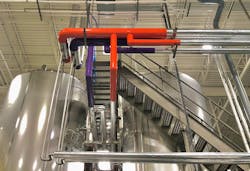Seven Best Practices for Inspecting Piping Insulation
By DOUG FAST, P.E., Technical Service Leader, Owens Corning
While process equipment is subject to stringent inspection schedules and preventative maintenance procedures, supporting components such as insulation systems protecting pipes are sometimes overlooked.
I was reminded of this oversight recently at an industrial facility when I placed my hand along a length of pipe. The heat radiating from the pipe through the insulation’s jacketing was a “red hot” signal that the insulating system hadn’t been inspected for a while.
Inspecting the insulation systems on mechanical piping is about much more than compliance. Done properly, it can help to protect both the equipment investment as well as the overall efficiency of the processes flowing through pipes. Below are some best practices for maintaining mechanical piping systems:
1. Establish and follow a regular inspection plan
Establishing and following a regular plan to inspect and maintain the insulation protecting mechanical piping can help maintain the system’s performance, contribute to efficient processing functions, and help employee safety. Regular inspection can also help prevent small issues from becoming larger and more costly problems.
2. Ensure an adequate amount of insulation is installed on pipes
A good place to start is considering the role that mechanical insulation plays in supporting HVAC processes. First, make sure the proper amount of insulation is in place and that it’s properly installed. Adequate insulation on mechanical pipes can help avoid wasted energy dollars from heat exiting the system. When properly installed, mechanical pipe insulation can help manage a facility’s operational costs and shrink its carbon footprint by reducing emissions and improving its energy efficiency.
Recent disruptions in energy supply and corresponding turbulence in the markets are making passive components, including insulation, increasingly important. Uninsulated or poorly insulated pipes in mechanical systems put added strain on the heating and cooling elements. Under-protected heat pipes may also pose a risk to employees.
3. Be alert to problems that can sabotage efficiency and safety
Holes, punctures and ordinary wear and tear can all conspire to sabotage a piping system and the efficiency of its operations. When insulation has been compromised, a building’s efficiency will be adversely affected because more energy is needed to maintain process temperatures. For example, in a gas heating system, natural gas will be used to generate heat, which also may lead to additional carbon emissions. Or in a steam heat situation, inadequate insulation can lead to cold spots developing and resulting in quality control issues. In this situation, colder-than-desired water temperature may add strain to the heater and reduce efficiency.
Depending on the type of system operating, damaged and missing insulation can also become a safety hazard. Hot steam pipes can reach temperatures above 200°F. Directly touching a pipe surface at this temperature would cause an instant burn. However, with the correct insulation in place, the surface of these pipes will still be noticeably warm, about 140°F, but not enough to burn.
4. Check areas where recent repairs or servicing was conducted
Inspecting the integrity of a mechanical insulation system is a low-tech venture but one that requires a good eye. Walk around the facility or plant and check for signs that insulation is missing, damaged, wet, discolored or showing signs of deformation. Pay special attention to any locations where repairs have recently been done to ensure that any insulation removed was replaced correctly and that worker foot traffic didn’t accidentally breach the system.
During inspections it is not uncommon to find situations where insulation was removed from piping to service a repair and not reinstalled afterward. Of course, an indirect way of determining whether insulation is doing its job is to check regularly to see if energy usage has increased unexpectedly.
5. Schedule insulation inspections similar to other routine maintenance
A best practice is to schedule routine inspections to be performed regularly by the head of facilities or maintenance. The frequency of inspection will depend on the activity and processes occurring at the facility. Insulation in lightly trafficked areas may not need to be checked more than once a year, while busy sites, or locations where there is the potential for damage from equipment movement, may need to be inspected every quarter. A common sense approach can be used to help establish how often reviews are needed or if something has changed and should prompt another walk-through.
6. Utilize a checklist
A checklist can bring consistency to periodic inspections. Signs to look for on every inspection include:
- Damage or discoloring of outer jacketing;
- Penetrations left unsealed;
- Loose or missing insulation;
- Areas where insulation has been removed and not replaced;
- Ice, mold, mildew or condensation on the jacketing;
- Jacketing that is sagging or pulling away from the pipe/support;
- “Hot spots” in the insulation system;
- Expansion or contraction joints that appear to be functioning incorrectly.
7. Make use of free resources to support inspections
Several organizations, including the National Insulation Association (NIA), provide guidance on what to look for when conducting inspection. NIA is also a rich resource for information on how to conduct an insulation inspection. Resources on the NIA website include design tips, installation information and a calculator to help assess insulation levels. This resource is intended for use by a reviewer who also is also a certified thermal insulation inspector.
At all times – but especially at moments of heightened market volatility and rising energy prices – inspecting and maintaining insulation can help support the operational efficiencies of HVAC processes.
Based in Littleton CO, the author is a research engineer with more than 20 years of industry experience and a proven record of understanding technical problems and developing creative, innovative solutions for engineers and designers.
